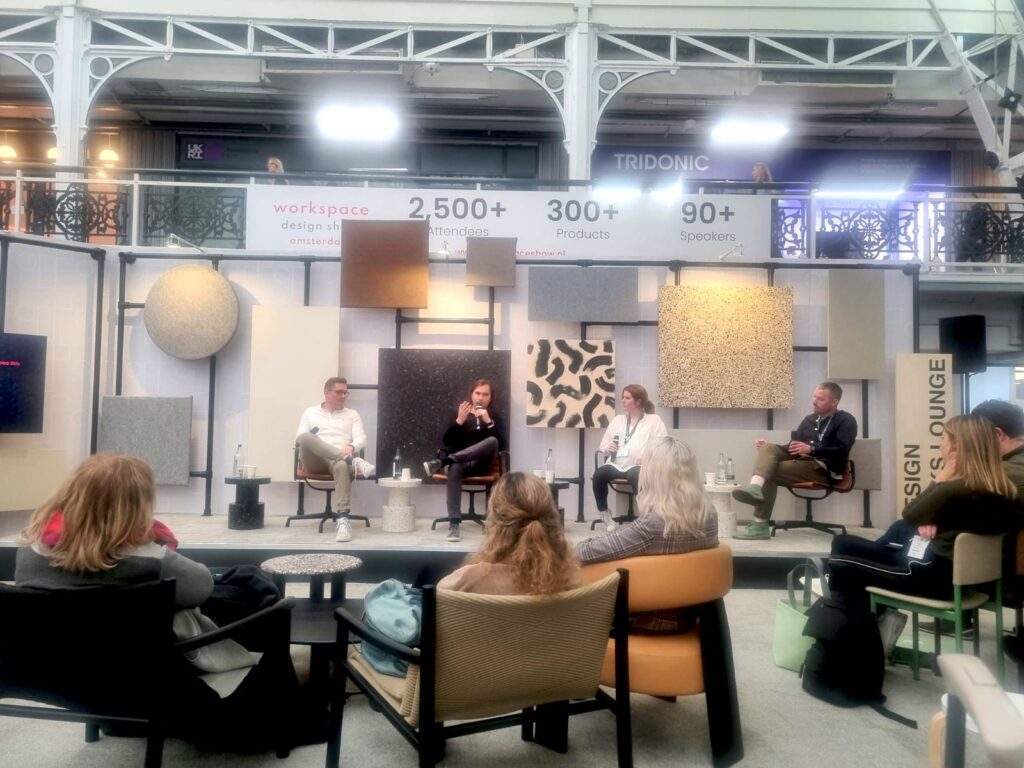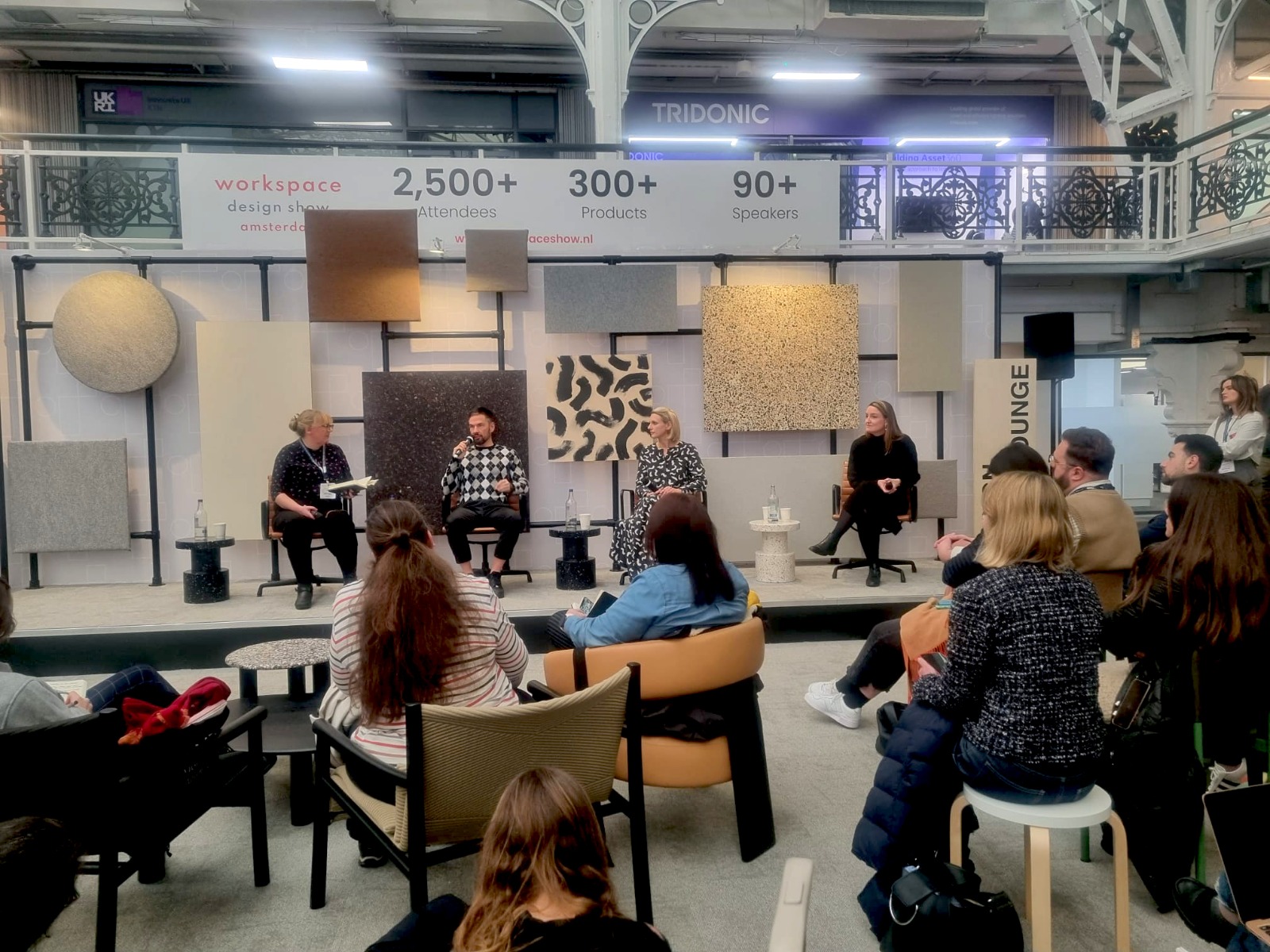The Workspace Design Show brings together the UK’s workplace interiors community to explore the experience of tomorrow’s workspaces. But in figuring out what tomorrow looks like, it’s important to understand what the starting point – today – looks like. To that end, the theme underpinning this year’s event was: ‘Destination Workplace: Places Where People Want to Be’. Apt given the ongoing challenge to lure the reluctant returners back to the office. I caught a few of the Design Talks Lounge panel discussions. Here, I paraphrase the key takeaways of not one, not two, but SIX architecture, design, workplace and property experts.
Creative pause…
Designers must figure out the problems that need to be solved, said Charlotte McCarthy, head of interiors at Heatherwick Studio. That’s the first step and each case will be different. But speaking generally, the gift workplaces can offer, if designed to do so, is to inspire a sense of togetherness. People tend to be more creative and productive when their day is peppered with those all important social, serendipitous moments, commented McCarthy. We need to consider the concept of a creative pause – the idea of inspiring the accidental creativity that often comes when one’s not expecting it, like those ‘in the shower’ moments – and find a way to replicate those subtle psychological cues in the workspace.
Data-driven approaches
Create environments that fuel experiences. That’s the key for Grant Kanik, partner of Foster + Partners, the global studio for architecture, engineering, urban and landscape design. Take a data-driven approach and marry the insight gleaned from the data with the creativity and innovation required to design a cohesive, innovative and essentially human ecosystem that supports the activities being undertaken, he suggested. It’s been proven that we can work in a distributed and asynchronous way. That’s here to stay. So, now our focus must be on dissolving the boundaries between digital and physical spaces. The tech must be invisible but also intuitive, argued Kanik. We should be more thoughtful, considered and eloquent about the purpose of a workspace design. The office is a physical manifestation of an organisation’s values after all. That’s why it’s so important to design for meaning.
Designing for people
This should go without saying, but it’s about designing for people – the employee, the employer, and the team’s needs. To do so, there must be a vision, stressed Shannon Pope-Ellis, MD of MCM: a north star to follow, along with the guiding principles that will light the way to helping a workspace design team unleash a space and a workforce’s potential. Everyone has to buy into that vision before that can happen, though, she reminded the crowd. It’s the design that sits on top of all that that excites and delights. But, ultimately, it’s about offering a frictionless day at work, which can be a challenge given the complexities of accommodating hybrid working and a dispersed workforce.
Office experience
We need to put ourselves in the shoes of the end user if we’re to carve out an outstanding experience, suggested Chris Hunt, director of V7, a creative and forward-thinking asset and development management company. It’s about making the office a fun place to be. Organisations are now offering health suites, complete with physio treatment rooms, roof terraces, gyms, yoga studios and Peloton rooms. The office space is important, sure, but it’s not the part that gives people a reason to come back, he argued. It’s about creating a hotel-like experience, something they can’t get at home.

The bare minimum
A lot of offices still aren’t offering good experiences, Michael Davis, founder & head of JLL Unlimited, pointed out. More often than not, there are friction points that clash with people’s different workstyle preferences. Now more than ever, it’s important to add those special touches, he said. This isn’t just about adding value. It’s not a ‘nice to do’. It’s actually a minimum requirement if corporate property teams are to stand a chance of enticing people back.
ESG ambitions
EDGE believes the world needs better buildings. That belief drives everything the real estate developer does. Becky Sleath, senior commercial manager, did Edge’s ambition justice during the panel discussion on the developer-tenant relationship – how that’s changing and what it means for the way we design workplaces. If you want to achieve your ESG ambitions, and do the best by the planet and people, then you have to work more collaboratively, she said. The likes of BREEAM, LEED and other environmental assessment methods and accreditations are becoming hygiene factors, rather than differentiators. Circular principles should be at the core of everything, Sleath argued. She also congratulated the market for doing a lot of work in that regard and for driving environmentally sustainable design forward. Although more work of course needs to be done.
What will be tomorrow’s workspace?
What will shape tomorrow’s workspace design, then? Well according to these experts and the rest of the speakers on the line up, the future approach to workplace design and management, and the communication that goes with it, must help encourage a sense of togetherness, connection and community spirit above all else. Yes, the workplace has to support concentrative and collaborative work. Organisations need to create environments, both on and offline, that foster creativity and innovation. Flexibility, agility and a variety of settings – not to mention the freedom to choose environments that work best for the individuals and teams in question – will be key in supporting activity-based working models that people require in their increasingly multifaceted and complex roles. But to get ahead, the workplace has to offer that special something and spaces to connect, to meet new people, to learn through osmosis, to be noticed, to inspire new ideas, and to promote a shared sense of purpose.








